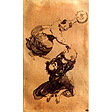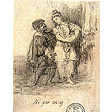
Sketch Albums







Eight collections have been identified:
|
|
Álbum A (1796)Album A, or the small Sanlúcar sketchbook, produced in the summer of 1796 during Goya's stay at the Duchess of Alba's estate in Sanlúcar de Barremuda. They are principally drawings of women: in intimate moments or involved in domestic activities, amongst which the Duchess herself has been identified. They have a great spontaneity and freshness. The drawings were made with brush and Indian ink with touches of charcoal and pen. They are thought to be the beginning of the Caprichos. |
|
Álbum B (1796-1797)Album B or the Sanlúcar-Madrid Album was started in Sanlúcar and is a clear continuation of the previous sketchbook with the same techniques and themes up to drawing no. 27. From there on, the scenes become more complex and have a highly dramatic air. One finds processions, asses, prostitutes and bandits. There is both a clear change of direction and a close relationship between these drawings and The Caprichos. The pages are numbered and for the first time titles related to each illustration appear. |
|
 |
Álbum D (1801-1803)Album D is the least important of the sketchbooks and is thought to be unfinished. It contains burlesque and grotesque subjects, visions from dreams, with one or two powerful sketches of flying witches, brothel madams, madmen, friars, etc. The sketches were drawn with brush and Indian ink. |
Álbum E (1883-1812)The Album with black borders. The sketches have a thick black line as a frame. They are the largest in size of the entire collection and are numbered at the top and centre of the page.They were the most carefully catalogued and worked on of his sketchbooks and differ from the others in terms of the subject matter. They deal with philosophy, knowledge, and some mythological subjects are also depicted. |
|
 |
Álbum C (1803-1824)Album C is the most important sketchbook of the collection because of the quantity of sketches and their personal character. Through them one can discover Goya's opinion of various matters: Pessimism about the absolutism of Fernando VII, belief in the liberal dreams after the proclamation of the 1812 Constitution, criticisms of the Inquisition. It is a complete chronicle, realistic and vivid, of what was happening around him, made real by means of scenes of prisons, people condemned to death, beggars, the tortured, victims of the Inquisition, satires of friars, and ever present among these scenes, cries for liberty and justice. All the drawings have titles which complete the expressive quality of the sketches. They were drawn using Indian ink, sepia wash or both. The style is very loose in comparison to the previous works, faster, less detailed. |
Álbum F (1812-1823)Album F contains drawing of great perfection, carefully prepared compositions and great homogeneity of subject matter: one of duels, another of huntsmen, fishermen and other more varied subjects such as processions, old people, soldiers, bandits and even the occasional wedding scene. The compositions are of great quality, both the landscapes and interiors. All were done with brush and sepia wash. The drawings have no titles. |
|
 |
Álbum G (1825-1827)Album G was the first Goya started after his arrival in Bordeaux and is a reflection of the novelties that he discovered there. One finds sketches of customs and activities seen in Paris and Bordeaux, the different modes of transport, scenes of the guillotine and French beggars mingle with his obsessions: witches, bandits, giants and erotic dreams. Then 80 years old, he was worried about his decrepitude, which is given shape on paper but with no loss of innovation. In this sketchbook he abandoned wash and used soft black pencil. |
Álbum H (1824-1828)Album H is a partner of the previous sketchbook and soft black pencil is also used. The one difference between them is that this book has no titles but the majority do have a signature. Various, habitual subjects are dealt with, gathered together to consider such subjects as his worries about death, justice, war and various memories which are all drawn with the usual mixture of the grotesque and the tragic. |
|
BibliographyGassier, P. Dibujos de Goya : Los álbumes. Barcelona, 1973. Gassier, P. Dibujos de Goya : Estudios para grabados y pinturas. Barcelona, 1975. Marisa Cancela |
|
 |
InfoGoya 96 is an initiative of the University of Zaragoza, sponsored by the Institution Fernando el Católico of the Deputation of Zaragoza on an Apple Internet Server donated by Apple Computer. |    |